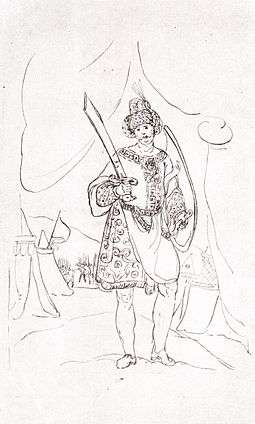Rostom of Kartli
| Rostom | |
|---|---|
|
King Rostom by Teramo Castelli | |
| King of Kartli | |
| Reign | 1633–1658 |
| Successor | Vakhtang V of Kartli |
| Born | 1565 |
| Died | 1658 |
| Burial | Qom, Iran |
| Spouse |
Ketevan Abashishvili Mariam Dadiani |
| Issue | Vakhtang V of Kartli (adopted) |
| Dynasty | Bagrationi dynasty |
| Father | David XI of Kartli |
| Religion | Islam |
| Signature |
 |
Rostom or Rustam Khan (Georgian: როსტომი or როსტომ ხანი) (1565–1658) was a king of Kartli, eastern Georgia, from 1633 until his death. Appointed by a Persian shah as a Wāli (i.e. viceroy) of Kartli, he styled himself king of kings and sovereign in Georgian customs.
Life
A son of Daud Khan, a Georgian prince and convert to Islam, by a concubine, he was born Khosro Mirza and brought up Muslim at the Persian court. An intelligent and resolute in his decisions, he soon attracted the attention of Shah Abbas I of Safavid who appointed him, in 1618, a darugha (prefect) of the capital Isfahan. From 1625 to 1626, he took part in suppression of the Georgian opposition: he commanded a right flank at the victorious Battle of Marabda and saved part of the Persian troops from a complete disaster at the Battle of Ksani. In 1626, Khosro Mirza was recalled from Georgia and appointed a commander of the Shah's guard Quli. In 1630, Abbas, lying on a deathbed, urged him to protect a grandson and heir Sam Mirza, the future Shah Safi, whom Khosro served faithfully. In 1630, he led a Persian army which defeated the Ottoman forces and captured Baghdad. In the early 1630s, he took part in sidelining and destruction of the Undiladze family which had dominated the Saffavid court for years. As a reward, he was appointed, in 1633, a wali of Kartli at the age of 67 and sent to suppress the opposition of Georgians who had managed to unite the eastern regions of Kartli and Kakheti under Teimuraz I for a brief period of 1630-1633. He adopted a name Rustam (Rostom, როსტომი, in Georgian transliteration) and came to Georgia with a large Persian army commanded by his fellow Georgian Rustam Khan. He soon took control of Kartli and garrisoned all major fortresses with Persian forces, bringing them, however, under his tight control. His willingness to cooperate with his suzerain won for Kartli a larger degree of autonomy. A period of relative peace and prosperity ensued, with the cities and towns being revived, many deserted areas repopulated and commerce flourished. Although Muslim, Rostom helped to restore a major Georgian Orthodox cathedral of Living Pillar (Svetitskhoveli) at Mtskheta, and patronised Christian culture. However, Islam and Persian habits predominated at his court. He ruthlessly crushed an opposition of local nobles, putting to death the catholicos Eudemus I of Georgia, and invaded, in 1648, Kakheti, forcing Teimuraz to flee to Imereti (western Georgia).
Throughout his reign, a question of succession appeared to be a challenging task. As he had no children, Rostom intended to make the Imeretian prince Mamuka his heir. The latter, however, was soon suspected to have been involved in a plot, and he had to return to his native Imereti. In 1642, Rostom adopted his kinsman Luarsab, the late Simon Khan's grandson, but he was assassinated in 1652 while hunting. Another candidate for the succession, Rostom's stepson Otia, also died young, in 1646. Only in 1653 was able Rostom to choose his successor. It was Vakhtang of Mukhrani, a representative of a junior Mukhrani branch of the Bagrationi dynasty, who actually ran government in the last years of Rostom, and succeeded on his death on November 17, 1658. Rostom was buried in Qum, Persia, close to his late suzerain Abbas I. The 19th-century British diplomat Robert Grant Watson reported in his A History of Persia, "in one of the finest of tho gardens adjacent to tho city was the mausoleum of Rustem Khan, a prince of the royal house of Georgia who had embraced the tenets of the Mahomedan religion in order to obtain tho viceroyalty of his native country."[1]
Family
Rostom was married twice. After his return to Kartli, he wed c. 1635 Ketevan, daughter of Prince Gorjasp Abashishvili.[2] Marie-Félicité Brosset,[3] followed by Cyril Toumanoff, erred in identifying her surname as Abashidze. The Abashishvili was a branch of the Baratashvili family. The wedding was celebrated in Christian and Muslim rites and Ketevan added a Persian name, Guldukhtar. The marriage was childless and Ketevan died shortly thereafter.
In 1638, Rostom concluded a strategic marital alliance with the Dadiani princely dynasty of Mingrelia. His second wife was Mariam, sister of Levan II Dadiani, the reigning Prince of Mingrelia, and the former wife of Simon Gurieli, Prince of Guria. They had no children. After Rostom's death, Mariam was married his adopted son and successor, Vakhtang V.
See also
Notes
- ↑ Watson, Robert Grant (1866). A History of Persia from the Beginning of the Nineteenth Century to the Year 1858. London: Smith, Elder and Co. p. 277.
- ↑ Rayfield 2012, p. 198.
- ↑ Brosset 1856, pp. 66, 626.
References
- Brosset, Marie-Félicité (1856). Histoire de la Géorgie depuis l'Antiquité jusqu'au XIXe siècle. IIe partie. Histoire moderne [History of Georgia from Antiquity to the 19th century. Part II. Modern History] (in French). S.-Pétersbourg: A la typographie de l'Academie Impériale des Sciences.
- Rayfield, Donald (2012). Edge of Empires: A History of Georgia. London: Reaktion Books. ISBN 1780230303.
External links
| Wikimedia Commons has media related to Rostom of Kartli. |
- (English) Iranian-Georgian Relations in the 16th- 19th Centuries
- (English) Georgians in the Safavid administration
| Preceded by Union with Kakheti |
King of Kartli 1633–1658 |
Succeeded by Vakhtang V |
